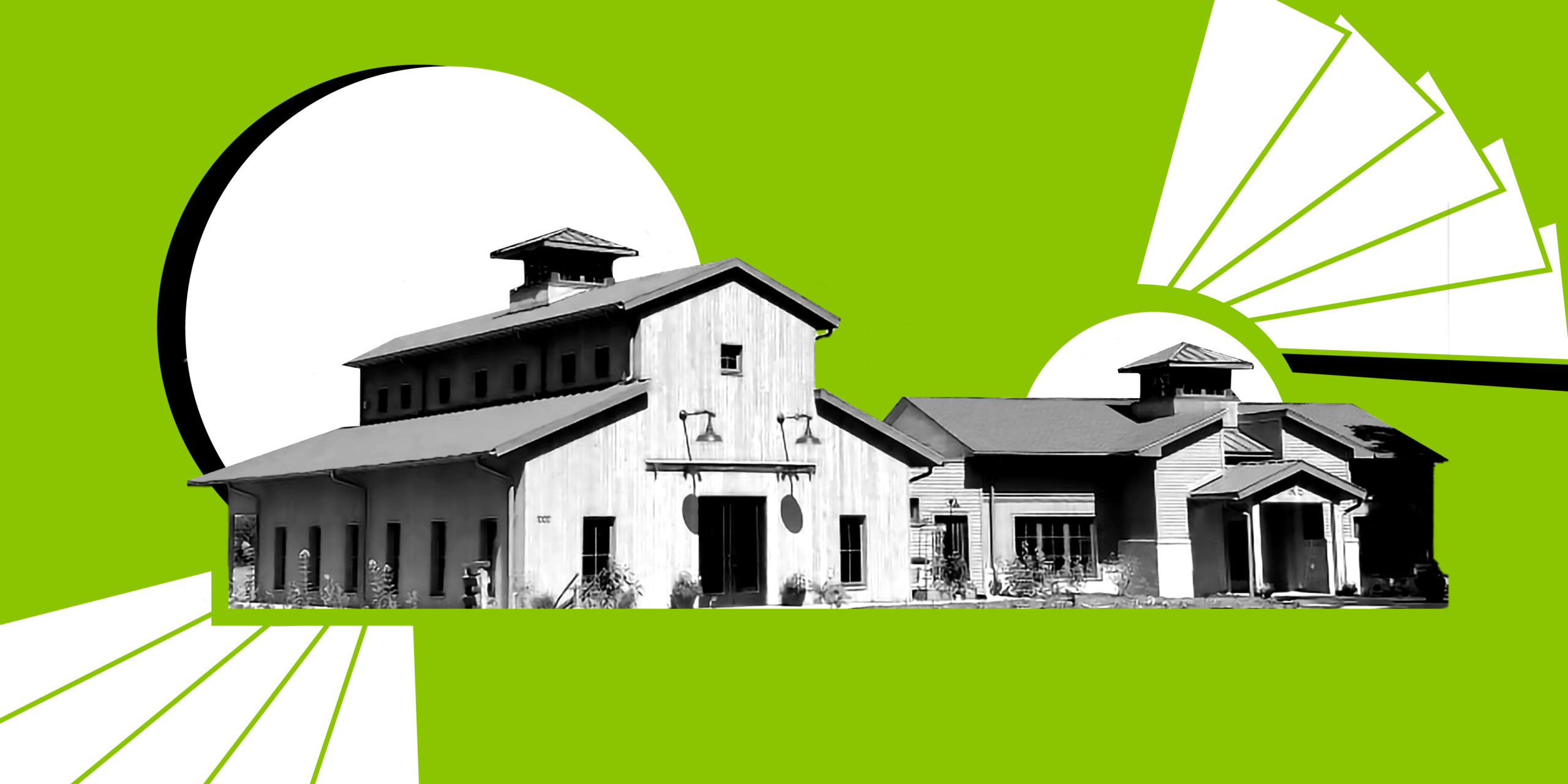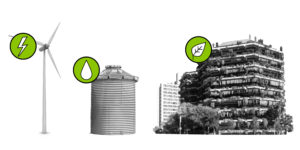
At first glance, the concept of regenerative design seems simple.
When architects ensure that their projects benefit the community and surrounding environment, everybody wins.
But putting this into practice can be difficult.
“Often in architecture school, you’re trained to just ‘do’ the building, separate from the broader social context,” says Ann Kosmal, FAIA, an architect who works in regenerative design in Washington, D.C. “By contrast, regenerative design is a framework for thinking about resilience in a community, and architecture is just a single part of that.”
The roots of regenerative design trace back to agricultural practices focused on renewing soils and enriching ecosystems. In 1978, Bill Mollison, a biologist in Tasmania, took the concept further by creating a set of design principles that integrate “the landscape with people, providing their food, energy, shelter and other…needs in a sustainable way.” Building on this idea, John T. Lyle, a professor of landscape architecture at California State Polytechnic University, Pomona, transferred these principles to the built environment and founded the Lyle Center for Regenerative Studies, to test how buildings can harmonize and contribute to the growth of the surrounding environment and community.
Regenerative design asks architects to do three things: Ensure that each project benefits and transforms the surrounding socioeconomic and ecological systems; align stakeholders to accomplishing those transformations; and explore how teams can develop value-adding processes that continue to indefinitely serve stakeholders beyond the project building and site. “There’s no such thing as a regenerative building,” says John Boecker, AIA, a founding partner at 7group consulting firm. “But there is regenerative design and development. Essentially, it’s about using the built environment as an instrument for enabling larger living systems to thrive by thinking big picture—what is it our clients care deeply about beyond the building?”
Three Ways Buildings Can Contribute to the Community

- Electricity generation for a distributed, resilient grid
- Rainwater collection and gray or black water filtration for healthy waterways
- Green roofs and native vegetation for community and habitat enrichment
Designing for & with your community
To begin the regenerative design process, architects must expand their thinking beyond a site’s physical boundaries, working to ensure each project benefits the surrounding community and environment through reciprocal relationships.
An example of a small-scale regenerative project is the RE Farm Café in State College, Pennsylvania. In 2016, Boecker and 7group were hired by local entrepreneurs who’d bought a farm in the lush Nittany Valley with the goal of creating a farm-to-table restaurant. Thinking beyond the restaurant itself, 7group helped the owners plan how to reach out to local farmers and the surrounding agricultural community (as well as Penn State) to create a new type of marketplace tied to the endeavor. Ultimately, everyone worked together to create a co-op, a community-supported agriculture initiative (CSA), a farmers market, an educational venue for learning about regenerative agricultural practices, and, of course, the restaurant, all of which sparked a new economic hub in the region. “The shift happened when the owners transitioned from just thinking about the café’s success to seeing its development as a way to embrace the broader goal of revitalizing the community’s ‘fooding’ system,” Boecker says. “The farm became the central node for everything else, with the restaurant an essential part of that. And now it’s a great success. When you engage everyone and align around potential, you can actualize remarkable transformations.”
The regenerative power of the RE Farm Café
In 2016, Monica and Duke Gastiger bought a farm in State College, Pennsylvania, planning to create a farm-to-table restaurant. But architect John Boecker, AIA, and 7group helped them achieve even more. Here’s how they used regenerative design to enhance the entire community, creating a successful restaurant in the process.

Helped found a CSA
The Gastigers created a community-supported agricultural initiative to send out weekly produce boxes and prepared food from the RE Farm Café’s own farm. Each box includes recipes and information about the produce of the week, and locals can meet with RE Farm farmers at pickup, to learn more about where their food comes from.
 Invited college students & community
Invited college students & community
Finally, the Gastigers invited students studying various fields at nearby Pennsylvania State University—including agriculture, sustainability, nutrition, engineering, architecture, landscape architecture, nursing, and hospitality management—to use the farm for educational purposes, helping to create the next generation of regenerative farmers and thinkers. Other community programs include interactive farm tours, classes for all ages, and local presentations.

Created an online market
The Gastigers helped set up an online market for local farmers to sell produce.
Turning collaboration into ambition
Architects must work to engage potential collaborators in regenerative projects, then use those partnerships to achieve additional goals. An example of this is the Iona Island Wastewater Treatment Plant in Vancouver.
In 2009, Bill Reed, AIA, a partner at Regenesis, a regenerative consulting firm, and Boecker met with officials at Metro Vancouver to discuss a new wastewater treatment plant located along the Fraser River on the north shore of the city. The Lions Gate Secondary Wastewater treatment plant would become an early example of meeting the country’s new legal mandate for treating primary sewage without dumping it directly into a body of water. In an effort to rethink the traditional concrete and razor-wire layout of a plant, Reed and Boecker helped Metro Vancouver, the project team, and the community co-create something ambitious: a treatment plant that produces energy while using the nutrients from the purification process to create a new park.
In 2019, Metro Vancouver approached 7group again with a larger project—the Iona Island Wastewater Treatment plant, to be sited where the Fraser River meets the Salish Sea. Looking at the location, Reed suggested including the local Musqueam First Nations population in the development process, since they had been fishing and navigating the region for millennia. Metro Vancouver representatives invited Musqueam representatives to participate, and together they reimagined the project through a regenerative lens, realizing its potential to reconnect the river with the sea, preserving and enhancing native bird habitats, and invigorating the depleted salmon and orca populations. By pinpointing how to develop the plant and correct previous developmental missteps in the area—including a series of land bridges, built in the 1960s, that blocked the river from connecting with the sea—the project team included 20 ecological projects to regenerate the larger ecosystem. The first phase of the plant is slated to be completed by 2030. “A project involving massive infrastructure like wastewater treatment is one of the longest engagements architects have with communities,” Reed says. “Because of that, we can really work actively with a community. There are always thousands of issues no one can agree on initially, but when you talk about what the place can be, that brings people together. It’s a safe territory to start a conversation.”
Boecker agrees. “When the team began to really understand the wisdom about the place that the Musqueam people possessed, we saw a shift in momentum,” he says. “In fact, we held the third workshop on Musqueam land, and indigenous thinking became an integral part of design thinking, helping to shift the project’s transformational potential.”
Using regenerative design to reshape Hawaii
In this video—which placed as a finalist in the AIA Film Challenge 2020—Joseph Valenti, AIA, the director of the Hawai’i Wood Utilization Team, and Matthew Lynch, the director of sustainability for the University of Hawai’i, discuss the Albizia Project—an innovative approach to sequestering carbon, restoring native forests, and reducing the state’s dependence on imports. “Regenerative design is more than just sustainability and green design,” Lynch says. “It’s about crafting an architectural solution to solve multiple social challenges.”
Regenerating communities for the future
Finally, architects should ensure that regenerative design continues to enhance communities for decades to come. A large-scale example of this is the Las Colinas Women’s Detention and Reentry Facility near San Diego, California.
In 2013, the County of San Diego created a new type of justice facility focused on reducing recidivism rates using normative design strategies, which promote social interaction among inmates, build trust in guards, and provide educational resources and career-building skills for community reentry. According to the Bureau of Justice Statistics, 75% of women and 63% of men in U.S. local correctional facilities have suffered from mental illness. Instead of merely detaining the incarcerated, Las Colinas incorporated design principles related to light, movement, and nature to improve quality of life and better prepare inmates for release. “We wanted to connect the environment with the human,” says Eric Carbonnier, AIA, Ph.D., an associate principal at HMC Architects in Los Angeles, California. “Inmates who get out and then return to prison is a huge problem in America. So we worked with the sheriff and facility managers to create a space where the inmates could be part of a productive work environment and avoid behaviors that would land them back inside.”
As a former student of the Lyle Center for Regenerative Design, Carbonnier drew on its principles to create a new type of justice facility. First, he laid out the site as a series of small campuses on a sprawling green lawn with no cells, encouraging mobility and a sense of community. Then he brought in more light to the buildings, installing windows throughout—a rarity for correctional facilities. Finally, he placed large murals of nature scenes on the walls, encouraging inmates to reconnect with the natural world. As a result, the 475,000-square-foot, LEED Gold–certified buildings have impacted the lives of inmates while serving as a model for rehabilitation design. “I’ve done time throughout San Diego,” an inmate said in 2019. “This is the first time I’ve ever learned and gotten some skills that I’m going to use to build a foundation for when I leave here.”
For Carbonnier, the justice facility was a life-changing project, one that showed him the power of regenerative design. “So many people outside the realm of architecture guided the project in a meaningful way,” he says. “It succeeded because it focused on the psychological and behavioral impact of the environment, and has become a model for future detention facilities.”
Going forward, architects can use regenerative design to influence the world beyond architecture. Eera Babtiwale, an associate principal at HMC Architects in Ontario, California, recently began working with her firm’s nonprofit Designing Future Foundations to make regenerative ideas more tangible for young students. Babtiwale and Pablo La Roche, an architect at CallisonRTKL in Los Angeles, are holding virtual workshops for students, teaching them about renewable energy by building solar-powered cookers, about water quality and conservation by building aquifers, and about waste prevention by reusing architectural samples to make musical instruments. “We’ve even hosted a virtual class with a school in South America to start an international conversation about energy, water, and waste,” she says. “The students learn how to implement regenerative principles during lab activities, gain a global perspective about these principles when they chat with schools across the world, and, most important, become inspired by what they learn and share it with family and friends. When what you taught someone takes on a life of its own? That’s truly regenerative.”
Kosmal agrees. “As architects, we often deal with people who are in positions of power,” she says. “Regenerative design is really about showing up and using the influence we have to improve the world, whether through social justice or environmental health. You can’t unsee pictures of George Floyd or the effects of climate change. So the question becomes: How are you going to use your skills to help make real change?”
The Blueprint for Better campaign is a call to action. AIA is asking architects, design professionals, civic leaders, and the public in every community to join our efforts. Help us transform the day-to-day practice of architecture to achieve a zero-carbon, resilient, healthy, just, and equitable built environment.